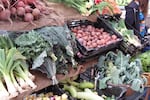Justin Novicky strolled up and down the rows of his greenhouse on a recent day, hand watering each and every one of his more than 400 tomato plants.
“All right, ladies!” he said, sprinkling each plant with water. “Thank you for providing such wonderful fruit, so many wonderful tomatoes!”
Related: After Damaging Winter, Oregon Businesses Choose To Rebuild In Idaho
These may be one-way conversations, but talking with his plants is part of Novicky’s recipe for growing tomatoes, a notoriously challenging crop for central Oregon. He also blasts reggae music from speakers at one end of his tall greenhouse.
“You know, giving them good vibes,” Novicky said. “Because if I come in here with a funky attitude or negative spirit, then they are going to take on that.”
In Oregon, places like the Willamette or Rogue valleys have a well-established reputation for farming. But a growing number of small farmers like Novicky are also making a mark on central Oregon’s local food movement — despite the region’s challenging agricultural conditions.
Tomatoes are the only crop at Novicky Farms, now in its third season.
“I remember one gentleman saying to me, ‘Oh what, are you a magician? You can’t grow tomatoes in central Oregon,” Novicky said. “And I said, ‘You’re talking to the magician, I apparently can do it.”

The temperature swing in Oregon's high desert climate isn't all bad news for produce —the cold snaps can help generate extra sweet root vegetables, like carrots.
Amanda Peacher / OPB
In central Oregon’s high desert climate, farmers have to take extra measures to reap a harvest. They struggle with sandy soil. The high elevation and short growing season mean frost-sensitive crops like tomatoes need to be reared in a greenhouse, or at the least, covered during cold spells.
"One thing I hear about farming in the [Willamette] Valley, is you toss a seed over your shoulder and it'll sprout," said Jess Weiland, food and farm director for the High Desert Food and Farm Alliance. "That is not the case in central Oregon."
Sometimes there’s a freeze in Bend as late as June and as early as August. But that’s not bad news for every crop. Root vegetables, for example, can sustain through multiple frosts in a season. The plant assumes that it’s about to croak, and diverts sugars from its leaves to the root. That can lead to to sweeter, crunchier carrots or beets.
Even though Novicky might have an easier time farming in a different climate, he’s happy in central Oregon. He sells tomatoes to a number of local restaurants like Deschutes Brewery and Ariana.
When the landowner at his farm’s former location decided to sell, Novicky started a crowdfunding campaign to stay afloat. The community rallied around him and his tomato farm, raising $12,000 to help construct a greenhouse at his new Tumalo location.
“From the chefs at the restaurants to all the locals that would visit us at farmers market, they really demanded this fresh produce,” said Novicky. “I can’t ask for a better place to reside to grow food for our community.”
As central Oregon grows, the demand for locally raised produce and meat is also increasing.
“We have a growing population. I think that’s no secret,” Weiland said. “So there’s a lot of opportunity to educate people as to where they can access fresh food and where they can engage with local farmers.”
To that end, the HDFFA hosted a "local food challenge" in early October. The nonprofit encouraged residents to take on daily tasks like finding a restaurant that sources locally or trying a new kind of meat.

Tess Vining cooks locally-raised lamb as part of the High Desert Food and Farm Alliance's local food challenge.
Amanda Peacher / OPB
Bend resident Tess Vining recently moved here from Corvallis, and decided that participating in the challenge would be a good introduction to the local food scene.
For the new meat challenge, Vining searched three different grocery stores for local meat before she found Locavore, which brands itself as central Oregon’s indoor farmers market.
After looking through freezers full of goat, alpaca, beef and lamb at Locavore, she settled on lamb. Technically she’s cooked lamb chops before, but not since her 6-year-old son, Kaden, was born.
At her home the next day, she pan-seared the lamb chops on her stove before finishing them off in the oven. Kaden helped her chop mushrooms for a wine reduction sauce to top the meat.
“We like to eat our meat medium rare, especially when it’s this high of quality,” Vining said as she flipped the lamb in the pan.
She and her boyfriend try to eat local as much as they can, but their grocery budget sometimes makes it hard. They tend to focus their dollars on local meat.
Related: How Farming Inside Wildlife Refuges Is Transforming Klamath Basin Agriculture
For Vining, buying local is about supporting farmers, but also about eating well.
“I always feel good about life when I’ve cooked a delicious meal,” she said. “Because I know good things are going to come.”
Despite the many challenges, more and more small farmers are choosing central Oregon. The food and farm alliance started tracking central Oregon farms through their annual published directory in 2012. Since then, the number of small farms has nearly tripled.
“Our farmers here have a lot of grit,” said Weiland. “And it makes them a lot more persistent, innovative and resilient."
If those persistent farmers are going to stay afloat, however, they need demand from the community.
The community's commitment to local food was tested earlier this year, when Locavore threatened to close its doors. The indoor farmer's market was sliding further and further into debt after expenses from a recent relocation added up. The shop ended up raising $25,000 from the community to bring it back into the black.
Shaili Parekh, program assistant for the HDFFA, said residents are starting to become more adventurous with new offerings at area markets.

Bend residents can find local vegetables at the Wednesday farmers market in downtown.
Amanda Peacher / OPB
ldquo;People are more open to eating a purple cauliflower,” she said. “Or parsnips — things you don’t always see in grocery store. That allows our farmers to work toward more diversity in their crops."
Parekh believes valuing locally grown foods meshes with the pride central Oregon residents have in the area's natural beauty.
“Central Oregon is really known for recreation, outdoor activities," she said. "We hope it’ll be just as known for local food.”